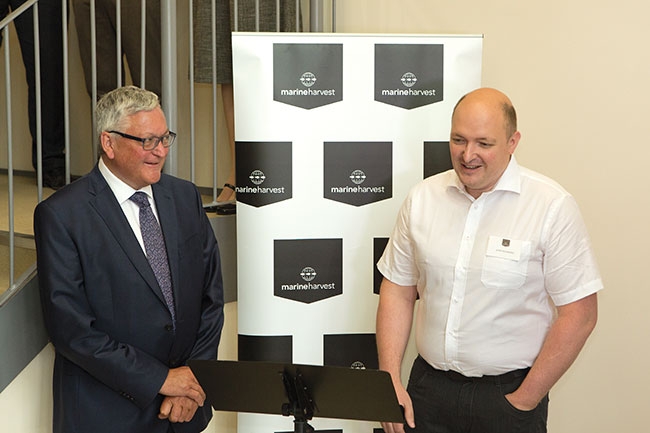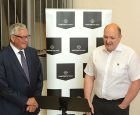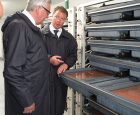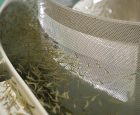
Features
Profiles
Inside Marine Harvest’s new Inchmore hatchery
Looking back at the opening of Marine Harvest’s new Inchmore hatchery, freshwater manager John Richmond is optimistic.
August 16, 2018 By Bonnie Waycott
 At the launch of Marine Harvest Scotland's new hatchery in Inchmore. (In photo Looking back at the opening of Marine Harvest’s new Inchmore hatchery
At the launch of Marine Harvest Scotland's new hatchery in Inchmore. (In photo Looking back at the opening of Marine Harvest’s new Inchmore hatchery“It’s going to be fantastic for parr and smolt production,” he said. “We’re looking forward to settling in, refining and developing our operations.”
The new hatchery was established to increase Marine Harvest’s capacity to supply smolts. As the company expands its seawater operations, a number of new offshore sites have recently opened. The Inchmore facility will provide the smolts required for the company to meet the increasing demand for its salmon. It opened in June so the first batch of smolts could be produced by September 2018, in line with the company’s seawater production plans.
The hatchery is similar to another Marine Harvest facility in Lochailort. Both use drum filters for particulate removal, have fixed bed submerged filters and a high amount of ozone injected within the recirculation process loop. But the biofiltration at the new Inchmore hatchery has been separated into two stages. The fixed bed filters are designed to have lower flow velocity and are primarily designed for fine particulate capture. Once the water has flowed through the fixed bed filters, it’s pumped up to a trickling biofilter where the majority of biofiltration occurs. The fixed bed filters at Lochailort need to both capture fine solids and perform the biofiltration, but by separating these processes at Inchmore, Richmond hopes to have provided a more optimal solution.
Covering 13,500m2, the hatchery has been constructed with 9,000m3 of concrete, 730 tonnes of structural steel and 1,500 tonnes of reinforcement steel. With 2,000kW of installed electrical capacity, it holds 4.6 million litres of water in the fish tanks, with 17.7 million litres in total.
Devil in the details
Rigorous measures are in place to ensure biosecurity and sustainability. All water entering the facility is subject to a batch sterilization process using ozone before being transferred to a new water holding tank and into the RAS (four for egg and alevin incubation, and four for the fry and smolt).
All eggs brought into the farm are certified disease-free and disinfected for any surface contaminants. Staff change clothing and footwear when entering the facility, while the egg incubation area and main building are in two distinct biosecure zones. Feed is brought into silos in a separate annex to the main building and distributed by a piped transport system to minimize any contact with feed bags and pallets in the biosecure area.
A vaccination machine is used so vaccination teams don’t need to enter the building, and all other inputs are controlled through disinfection areas, so stock can be secured in a disease-free environment. This is especially important for the early life stages when the stock is more vulnerable. The facility is also as energy efficient as possible, with efficient heating and cooling systems and LED lighting.
Community impact
The new hatchery created 12 new jobs and is expected to offer more as additional fish being added will create more employment opportunities further down the value chain in seawater, processing and sales.
Community initiatives have benefitted with the construction project helping to refurbish a community hall in a village neighboring the new facility, and ancillary equipment such as pumps, vaccination machines and hatching equipment have been supplied by the wider aquaculture industry.
In the past year, Marine Harvest reported considerable improvements in the survival and growth rate of salmon at sea, thanks to its investment in methods to tackle sea lice and improve fish health. Richmond is confident that the new hatchery will enable this to continue.
“By producing the smolts in an environment where we can optimize water quality and provide stable conditions for growth, we hope to produce smolts that perform well at sea,” he explained. “A healthy smolt able to achieve its full growth potential will be ready to withstand the challenges of sea water production and reach a harvest size in good time, thus minimizing the risk of cumulative issues in later parts of the seawater production cycle.”
Hopes are high for the latest stage in Marine Harvest’s expansion, as the Inchmore hatchery becomes part of a bright future for Scottish aquaculture.
Print this page









